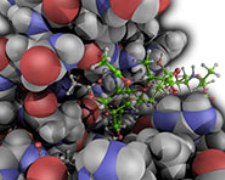Oct 19 2013
What makes enzymes such fantastic catalysts? New research from the University of Bristol is significantly advancing our understanding of how these proteins increase the rate of chemical reaction.
 Structures from QM/MM modelling of enzyme-catalysed reactions
Structures from QM/MM modelling of enzyme-catalysed reactions
Using a combination of experimental approaches and multiscale computational methods, including the hybrid QM/MM (quantum mechanics/molecular mechanics) approach for which Karplus, Warshel and Levitt won this year's Nobel Prize for Chemistry, the team of researchers from England, Wales and Spain studied the enzyme dihydrofolate reductase – an important target for anti-infective and anti-cancer drugs.
Understanding exactly how enzymes increase reaction rates – typically much more effectively and under more environmentally friendly conditions than artificial catalysts – is an important goal in biotechnology. Therefore, a thorough understanding of how enzymes achieve their phenomenal rate enhancements is of great importance to fields like biocatalysis, bioenergy, drug design and the emerging field of synthetic biology.
Despite the development of several theories to explain the enormous catalytic power of enzymes, even after a century of study it is not fully understood. Some recent theories have proposed that internal ‘promoting motions’ of the enzyme – specific motions that act to reduce the height or width of the energy barrier to the reaction – are used to drive the chemistry. This remains a topic of considerable debate, particularly since the identification and analysis of dynamical effects in enzyme-catalysed reactions has proved very challenging.
The team, which included Dr David Glowacki, Professor Jeremy Harvey and Professor Adrian Mulholland from Bristol's School of Chemistry, were able to alter the enzyme’s motions on a wide range of timescales whilst leaving its chemical properties unchanged. They found no significant role for ‘promoting motions’ in the reaction, but did demonstrate a general coupling of enzyme motions to the catalysed reaction.
Professor Mulholland said: "Our work shows that enzyme motions are involved in the reaction through a passive rather than an active mechanism, and ultimately indicates that enzymes are not fundamentally different from man-made catalysts, they are just much better.
"This is an important thing to establish as knowing how enzymes work has far-reaching implications, for example in biotechnology and synthetic biology, and should help in the design of effective 'green' catalysts in the future."
The work is published in Proceedings of the National Academy of Sciences (PNAS). It was conducted by researchers from Cardiff University, Jaume I University, Castelló, the University of Bristol and the University of València.
Paper
'Unraveling the role of protein dynamics in dihydrofolate reductase catalysis' by Louis Y. P. Luk, J. Javier Ruiz-Pernía, William M. Dawson, Maite Roca, E. Joel Loveridge, David R. Glowacki, Jeremy N. Harvey, Adrian J. Mulholland, Iñaki Tuñón, Vicent Moliner, and Rudolf K. Allemann in PNAS